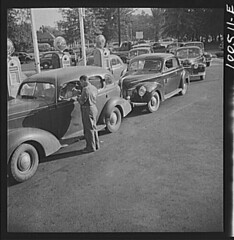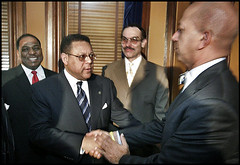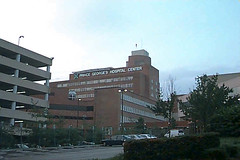Lessons from History regarding the proposal for the "National Capital Medical Center"
 Washington, D.C. On morning of July 21st, 1942 the last day before stricter gas rationing went into effect, cars were parked in front of gas stations long before they opened, waiting to fill their tanks on the quota of their old ration cards. Cars were parked and left without their drivers who returned at eight o'clock when the station on upper Wisconsin Avenue near the District line opened. Photographer Marjory Collins, OWI collection. Library of Congress.
Washington, D.C. On morning of July 21st, 1942 the last day before stricter gas rationing went into effect, cars were parked in front of gas stations long before they opened, waiting to fill their tanks on the quota of their old ration cards. Cars were parked and left without their drivers who returned at eight o'clock when the station on upper Wisconsin Avenue near the District line opened. Photographer Marjory Collins, OWI collection. Library of Congress. There is a story in the book When Washington Went to War by David Brinkley, about William Knudsen, the nation's manufacturing czar in charge of mobilizing industry for the war effort, and the auto industry.
The reason that there was gas rationing in WWII wasn't because there wasn't enough oil. There was plenty oil (the U.S. would not hit maximum oil production until around 1970). But back then rubber was derived from tree sap, and the Japanese took control of the rubber production areas of Malaysia, meaning no more rubber for the duration of the war. Gas rationing was instituted to reduce tire wear.
The auto industry stopped producing cars during the war, and converted to the production of all sorts of war materiel. Nonetheless, some cars were left over from 1941 that they wanted to sell, but they didn't have tires to put on the cars. They implored upon Knudsen (who had been the president of GM) to let them ship the cars to dealers, but without tires. He said no, because he knew once the cars were at a dealership, citizens and the auto dealers would implore upon their Congresspeople and the like to get tires, and the politicians would try to accomodate them, rather than the war effort.
Today's newspapers have articles about the new deal between Howard University and the Distsrict of Columbia government about the creation of a new National Capital Medical Center.
 Howard University chief H. Patrick Swygert and Mayor Anthony A. Williams seal a deal to build the National Capital Medical Center. Photo Credit: By Linda Davidson -- The Washington Post. Councilmembers Orange and Gray are in the background in this photo.
Howard University chief H. Patrick Swygert and Mayor Anthony A. Williams seal a deal to build the National Capital Medical Center. Photo Credit: By Linda Davidson -- The Washington Post. Councilmembers Orange and Gray are in the background in this photo.Which yesterday Councilmember Cropp was quoted as saying that going through the Certificate of Need process is important, but that it shouldn't be undertaken only to "derail the project." What about a fair and objective evaluation of the need, especially with regard to the real question of hospital care vs. health care and improving healthy outcomes? The whole reason the CON process exists is because most communities, including DC, have more hospital beds than patients to fill the beds--which is but another reason to look more carefully at how the healthcare system is structured, and whether or not this structure of delivery needs to be changed.
The letter to the editor in today's New York Times by Dean Baker (it was working on his Congressional campaign back in the 1980s in Ann Arbor that led to my fervent adoption and understanding of the "input, throughput, output publics" principle from Lauffer's Strategic Marketing for Not-for-Profit Organizations) who is co-director of the Center for Economic and Policy Research, wasn't written about the health care situation in DC, but what he wrote (in response to a column by Thomas Friedman), is just as apt when considering this hospital deal:
The dramatic budget scare story that Thomas L. Friedman cites has little to do with the baby boomers and demographics. It is overwhelmingly attributable to a broken health care system. The American health care system costs more than twice as much per person as that of other rich countries and produces worse outcomes. Its costs are projected to become even more out of line in the future. In addition to inflicting great damage on the private sector, rising health care costs will impose huge budget costs through Medicare and Medicaid. People should talk about this as a problem with the health care system, not a problem with entitlements.
Is the District of Columbia Government helping to further break a broken health care system?
The issue is what kind of health outcomes do we want in the District of Columbia and how do we best answer this question and develop a system to produce these outcomes? Jumping forward and constructuing a new hospital without even asking this question is a mistake.
Getting back to rubber rationing, this sentence, from the Post article "District, Howard U. Sign Pact for Hospital: Nonprofit Would Own SE Facility," scares the hell out of me:
Williams (D) has stipulated from the start that the city would agree to no ongoing subsidy, but last October, a draft report made the university accountable not just for those initial operating deficits but for anything that followed. In the 25-page document signed yesterday, however, neither partner "shall have any obligation . . . to provide additional financial support to NCMC" after the third year.
So what happens after the third year, and if the facility is losing money? (This is irrespective of all the arguments about "hospital care" vs. "health care".)
You don't think that there will be tremendous pressure on the District of Columbia to change the agreement, and come up with more money. After all, there is a brand new hospital open for (not enough) business that needs more money to stay open?
This happens all the time, not just within the District of Columbia on a wide variety of projects, but across the country in terms of hospitals and the frequent requests to local governments for more money.
Without even having to wrack my brain, two examples, Los Angeles County General-Drew Medical Center and the Fisk University Hospital in Nashville, come quickly to mind... Closer to home is the ongoing saga of both Greater Southeast Hospital in DC, which could be bankrupted by the creation of the NCMC a few miles away, as well as the continuing financial problems of Prince Georges Hospital (see "Shakeup, Bailout Sought for Maryland Hospital".)
What kind of financial implications are being imposed on other institutions by this agreement?
_______
For another perspective, see this article from the Detroit News, about competition and difficult negotiations between the Wayne State University Medical School, which provides doctors and students, and the Detroit Medical Center, in Detroit: "WSU, DMC labor over contract: Failure to reach deal by March 31 would mean an end to the 22-year relationship."
And these previous blog entries:
-- More ideas health care vs. hospital care -- school-based clinics (October)
-- Another troubling article in today's Washington Post (November)
-- Sound health care planning, or not, in the District of Columbia (October)
-- The National Capital Medical Center -- Better Health Care or just one more example of the Edifice Complex? (August)
-- CVS Health Clinics in the Maryland suburbs -- what does this mean for DC hospital planning (October)
-- More about store-based health care services (October)
Correction: an earlier version of this post listed Vanderbilt University Hospital, rather than the hospital associated with Fisk University Medical School, as an institution that sought funds from the local government, beyond amounts previously committed.
 Prince George's County Hospital.
Prince George's County Hospital.Index Keywords: health-care-planning



0 Comments:
Post a Comment
<< Home